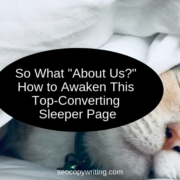Language, Context and Conversions: Thoughtful Prose from the Pros
 Guest post by Gabriella Sannino, SEO Copywriting Expert of Level 343
Guest post by Gabriella Sannino, SEO Copywriting Expert of Level 343
Words mean things: how you write those words, and in what context, can mean the difference between a conversion and someone falling out of the sales funnel.
The English language is so complex, a single comma and space can make the difference on how a sentence reads.
For example:
What’s in the road ahead? vs. What’s in the road, a head?
Does anybody have a pair of pants? vs. Does any body have a pair of pants?
We have words that sound the same:
Please cite the site about sight.
We have words that are spelled and sound the same:
I hit the bat with the bat.
We even have words that are spelled the same, yet sound different:
I bow to your fantastic bow tying.
Then, you have commonly misspelled words, like “are” and “our”, not to mention “to”, “two”, “too” or “they’re”, “their”, and “there”. Egads! No wonder writing copy is so fraught with danger! It makes a person wonder… what on earth is my website really saying?
Writing Sans Thought
Who hasn’t seen examples of poorly written headlines? I’m sure the writer thought they were absolutely fantastic, yet, somehow headlines like these managed to get pass writer, editor and preprint without a pause:
- Police Begin Campaign to Run Down Jaywalkers
- If Strike Isn’t Settled Quickly, It May Last Awhile
- Miners Refuse to Work After Death
How about the ads that didn’t say quite what the marketer intended?
- Illiterate? Write today for free help. (Ummmm….)
- 3-year-old teacher needed for pre-school. Experience preferred. (Isn’t child labor illegal?)
- Used Cars: Why go elsewhere to be cheated? Come here first! (Really? No thanks!)
The point is, sometimes we don’t think beyond our meaning of something, even if we think deeply about what we’re trying to say. When it comes to things like optimized writing, or writing copy for conversions, not thinking outside the box can lose you traffic and conversions.
For example, when someone searches for “red apple,” what are they actually searching for? There are several possibilities:
- Images of a red apple
- The fictitious “Red Apple” cigarette brand
- The Red Delicious Apple
- A rock band
- A book
- A red cover for their Apple computer
When you’re writing, you have to get creative. Especially when writing in the English language, you have to look over your content and ask, “How many ways can this headline, ad, sentence, article or blog post possibly be misunderstood?” You can rest easy knowing there will be at least one person who doesn’t read it the way you intended.
The Internet – Exciting, Adrenal-Driven Action
The Internet isn’t passive. When you search online, you plan to do something: buy, learn, play, find. As soon as you go to Google, Yahoo or Bing, you’re on the hunt. Your senses come alive; your heartbeat might even raise a thump or two. You have a point of pain, and, like any flesh and blood creature, you’re going to do the sensible thing: you’re going to pick at it until it quits hurting.
I submit to you today that every search query ever entered started with the subconscious thought: “I have a problem.” Whatever that problem is, is the point of pain. The point of pain for your visitor is what you need to address in your writing. Examples:
- Play: I have a problem. I’m bored. I want to play: online games; new games; games that match my old system’s capabilities.
- Find: I have a problem. I’m looking for: the closest Walgreens; Timbuktu; Brazilian skinny jeans in Orlando.
- Learn: I have a problem. I need to know: what “antidisestablishmentarianism” means; if cat pee really glows in the dark; if I can dye a grey tracksuit and make it lemon colored.
- Buy: I have a problem. I need to buy: iPod accessories; 6 inch spike heels for cheap; carving pumpkins.
When you’re writing, you have to dig into your target visitor’s mind:
- What is their point of pain?
- What’s their problem?
- How are you going to catch their interest?
- What words can you use that relate to their problem?
- How will you solve their pain?
Why does this matter?
Language is an important aspect of the Internet. It’s not just about context, semantics, etc; you now have to look at the language spoken by your followers. In other words, niche-specific slang.
If it means using words your readers are used to and excited by, then use those words – cause them to act! It doesn’t matter how much traffic you get, how much your visitors like you, or even if they talk about you as if they’re madly in love. None of it really matters, when you get down to it, if they don’t act.
What’s the Context?
Some of you would be amazed by how much understanding we gain from context. With the way the English language is put together, we have to have context. Consider these two sentences:
Bear with me.
There’s a bear with me!
Two words make all the difference in our understanding of what’s being said. When targeting visitors, we can use context and semantics to help narrow the possibilities. By adding words such as “Delicious” to “red apple” in our content, we can narrow the possibility of showing up for a non-related search query.
A fascinating example of focused copy is the “how to” content market. “How to” directly responds to the visitor’s point of pain. It promises a solution to their problem. The words following “how to” provide the context.
Keep in mind who’s boss here. Hint: it’s you. You decide the terms you want to target for ranking, how you want people to find your site, what image you want them to get of your business and so on. How people search and what they search to find your business is all up to you…
Just make sure you have the language right, so when they do find your search snippet it doesn’t make you look like a mook:
- Transcriber: Document Your Business Dealings – Misspellings Free!
- We Do Grass Right!
- 7 Reason to Higher a Copy Righter
- How to Sing: For Those Who Cant
And Just When You Think You Have It Down Pat…
Market research through A/B testing, data research and so on can help you pinpoint what words, headlines and article tones bring the best reactions. You can test, for example, an article based on facts vs. a humorous article with the same information. You can test funny images to lighten up a dry article. You can test headlines, word choices and everything else – don’t be afraid of creativity.
Yet, just when you think you know everything about your readers, buyers, clients and search engines, along comes more fuel on the fire: collective intelligence. Feeds given and curated by your readers; social commentary gathered into a central collective; the availability of massive amounts of information (although this information is not universally known); marketing research that’s there for the taking … Stay tuned!
Gabriella Sannino is the owner/operator of Level 343, a copywriting and SEO company. She specializes in depth analysis, hard data, strong copy and tested SEO techniques to bring traffic and conversions to business websites. Her passions in brand building through social media, marketing techniques and writing strong copy that converts are all part of the strategy.





Nice to see some of the old ideas revisited. As McLuhan said in 1951:
“…since these programs of commercial education are so much more expensive and influential than the relatively puny offerings sponsored by schools and colleges, it seemed fitting to devise a method for reversing the process”.
and
“..this procedure(looking at the artifacts of commercial education)would help to promote that unprecedented self-awareness which harmonious life in an industrial society requires”.(Mechanical Bride,1951 pp v and 45)